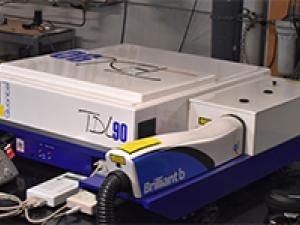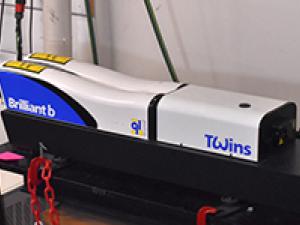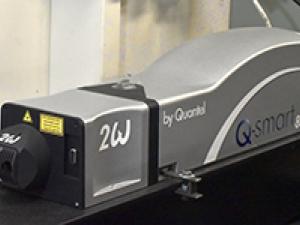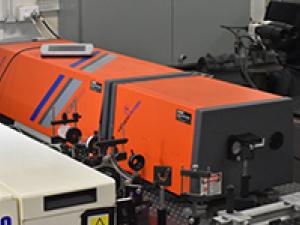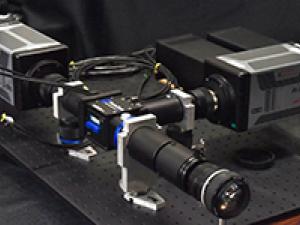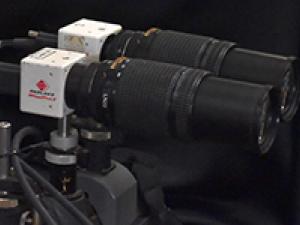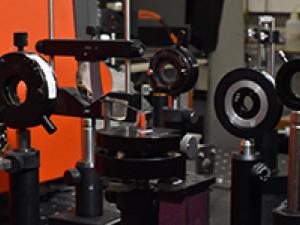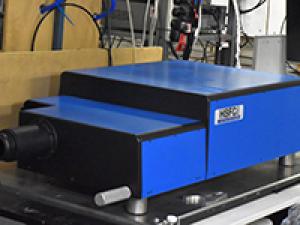Sooting flames
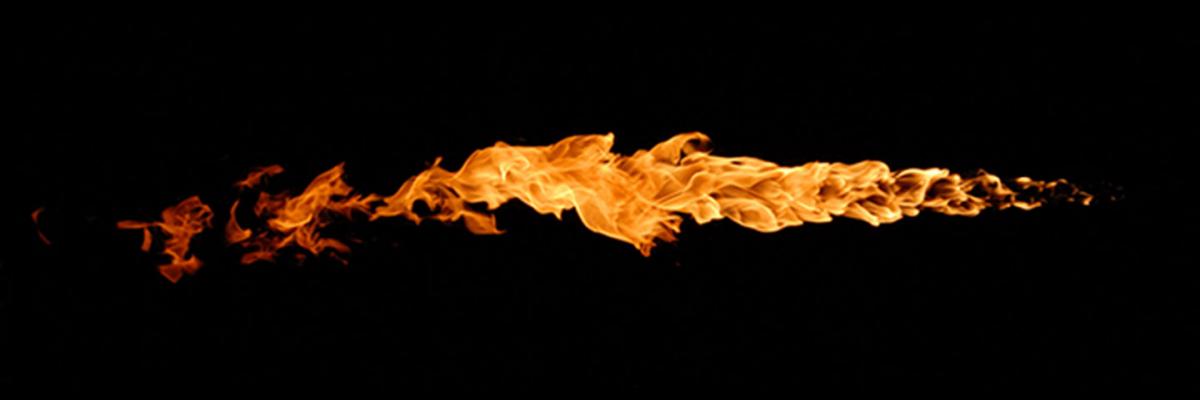
Our laser laboratory is providing vital new data and understanding to help to meet the global challenge of developing the reliable engineering models of soot evolution in flames. This work, is contributing to the development of clean combustion systems and is being undertaken in collaboration with the International Sooting Flames Workshop (ISF).
These clean combustion systems are expected to be an important component of the affordable, secure and sustainable energy systems of the future, particularly for key applications such as air transportation, peaking power and process heat. However, new technologies are needed before combustion can be clean, both for the production of new, more sustainable fuels and for their utilisation with near-zero emissions.
Soot can be desirable or undesirable, depending on the application. It is desirable within furnaces and boilers as the key component responsible for radiant heat transfer and also for applications such as rubber, which is derived from “carbon-black” – another form of soot. On the other hand, soot emissions from combustion systems are highly undesirable, since fine particle emissions are a leading cause of death and soot is also the second biggest global warming contributor after CO2. However, while technology has been developed to meet current air pollution standards, new understanding and models are needed to meet the anticipated future standards.
-
Background
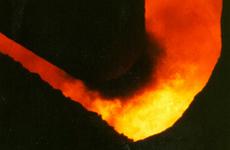
The “Gyrotherm” burner developed by CET researchers in partnership with FCT in a cement kiln. The yellow colour derives from soot, which provides the radiant heat transfer needed for the process.
Despite many advances in the understanding of soot evolution in flames, the processes that control it are so complex that current models cannot predict them reliably, particularly in turbulent flames. This is because both the chemical pathways that produce and oxidise soot, and the turbulent transport and mixing processes within a flame are both complex and non-linearly coupled.
The scale of the challenge of achieving reliable prediction in these conditions is so great that it can only be met through a coordinated global endeavour. For this reason, the International Sooting Flames Workshop has been established to bring together leading experimentalists, modellers and theoreticians to generate the required insights and provides the high fidelity data needed for assessing the performance of different models applied to a series of “target flames”. These test case are purpose designed to provide rigorous testing of models under simplified conditions of relevance to practical flames.
The development of predictive models requires high quality experimental data obtained from a series of flames, so that the models can be assessed for a range of conditions, using burners that are purpose designed for the development and validation of models. Such data are usually provide most reliably with optical diagnostics obtained with laser excitation, since these are non-intrusive, selective and typically provide the best spatial and temporal resolution. Various teams around the world are continuing to advance the development of methods of parameters with a flame, such as soot volume fraction, temperature and particle size, together with the soot precursor molecules.
-
Research activities
Our team is continuing to develop and apply new state-of-the-art optical diagnostic measurements for measurement in flames with soot. We target planar (i.e. two dimensional imaging) techniques, which are suitable for laminar as well as turbulent flames. The key methods we have established in our laboratory are:
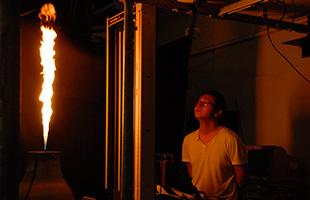
- Planar measurement of temperature using two-line atomic fluorescence of indium (TLAF)
- Planar measurement of soot volume fraction using laser induced incandescence (LII)TEXT
- Planar measurement of primary particle diameter using time resolved laser induced incandescence (TiRe-LII)
- Planar imaging of the position of the OH radical with planar laser induced fluorescence (OH-PLIF);
- Planar measurement of velocity using particle image velocimetry (PIV)
Our team has applied our laser diagnostic techniques to a series of flames, the results of which have been published in leading international journals and are also available for the international community through the ISF website. Many of these have been selected as targets for modelling by the Workshop. The key flames investigated to date are:
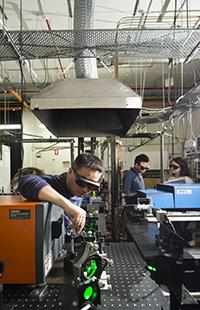
- A series of three flames with different type of burner nozzle to compare the effect of global strain rate on soot;
- A series of flames with either constant strain rate or constant Reynolds number, providing simultaneous measurement of temperature and volume fraction;
- A series of bluff body flames to assess the effect of hydrogen addition on soot;
- Simultaneous measurements of temperature, soot volume fraction and primary particle diameter in a flame previously investigated by collaborators in DLR, Stuttgart, both to cross check measurement accuracy and provide new data;
- A series of laminar flames in which the effect of dilution with hydrogen or nitrogen was systematically varied, providing measurement of temperature, soot volume fraction and primary particle diameter;
- A series of investigations reporting the influence of high flux irradiation on the soot and temperature in a flame, reporting soot volume fraction and temperature.
- A pool fire burning a range of fuels, measuring soot volume fraction.
-
People
Academic and research staff

Professor Gus Nathan
Professor
Professor Bassam Dally
Professor
Associate Professor Zeyad Alwahabi
Asc Prof
Associate Professor Paul Medwell
Asc Prof
Dr Zhiwei Sun
Research Associate
Dr Michael Evans
Research Associate -
Partners & collaborators
The sooting flames research group actively collaborates with researchers from across the globe. Current collaborators include:
- Professor Heinz Pitsch, RWTH Aachen, Germany;
- Professor Assaad Masri, University of Sydney, Australia;
- Professor Eric Eddings, University of Utah;
- Dr Michael Mueller, Princeton University, USA;
- Dr Klaus Peter Geigle, DLR Stuttgart, Germany;
- Dr Murray Thomson, University of Toronto, Canada;
- Dr Chris Shaddix, Sandia National Laboratory, Livermore, USA.
-
Facilities & equipment
-
List of publications
Listed below are selected recent publications on the topic of sooting flames.
Journal articles
[1] Z.W. Sun, B. Dally, G. Nathan, Z. Alwahabi, Effects of hydrogen and nitrogen on soot volume fraction, primary particle diameter and temperature in laminar ethylene/air diffusion flames, Combustion and Flame, 175, 270-282 (2017). doi: 10.1016/j.combustflame.2016.08.031.
[2] S.M. Mahmoud, G.J. Nathan, Z.T. Alwahabi, Z.W. Sun, P.R. Medwell, B.B. Dally, The effect of exit strain rate on soot volume fraction in turbulent non-premixed jet flames, Proceedings of the Combustion Institute, 36, 889-897 (2017). doi: 10.1016/j.proci.2016.08.055.
[3] A. Jocher, K.K. Foo, Z.W. Sun, B. Dally, H. Pitsch, Z. Alwahabi, G. Nathan, Impact of acoustic forcing on soot evolution and temperature in ethylene-air flames, Proceedings of the Combustion Institute, 36, 781-788 (2017). doi: 10.1016/j.proci.2016.08.025.
[4] D.H. Gu, Z.W. Sun, B.B. Dally, P.R. Medwell, Z.T. Alwahabi, G.J. Nathan, Simultaneous measurements of gas temperature, soot volume fraction and primary particle diameter in a sooting lifted turbulent ethylene/air non-premixed flame, Combustion and Flame, 179, 33-50 (2017). doi: 10.1016/j.combustflame.2017.01.017.
[5] K.K. Foo, Z.W. Sun, P.R. Medwell, Z.T. Alwahabi, B.B. Dally, G.J. Nathan, Experimental investigation of acoustic forcing on temperature, soot volume fraction and primary particle diameter in non-premixed laminar flames, Combustion and Flame, 181, 270-282 (2017). doi: 10.1016/j.combustflame.2017.04.002.
[6] D.H. Gu, Z.W. Sun, G.J. Nathan, P.R. Medwell, Z.T. Alwahabi, B.B. Dally, Improvement of precision and accuracy of temperature imaging in sooting flames using two-line atomic fluorescence (TLAF), Combustion and Flame, 167, 481-493 (2016). doi: 10.1016/j.combustflame.2015.09.028.
[7] X. Dong, Z.W. Sun, D.H. Gu, P.J. Ashman, Z.T. Alwahabi, B.B. Daily, G.J. Nathan, The influence of high flux broadband irradiation on soot concentration and temperature of a sooty flame, Combustion and Flame, 171, 103-111 (2016). doi: 10.1016/j.combustflame.2016.05.026.
[8] Z.W. Sun, D.H. Gu, G.J. Nathan, Z.T. Alwahabi, B.B. Dally, Single-shot, Time-Resolved planar Laser-Induced Incandescence (TiRe-LII) for soot primary particle sizing in flames, Proceedings of the Combustion Institute, 35, 3673-3680 (2015). doi: 10.1016/j.proci.2014.07.066.
[9] Z.W. Sun, Z.T. Alwahabi, D.H. Gu, S.M. Mahmoud, G.J. Nathan, B.B. Dally, Planar laser-induced incandescence of turbulent sooting flames: the influence of beam steering and signal trapping, Applied Physics B-Lasers and Optics, 119, 731-743 (2015). doi: 10.1007/s00340-015-6080-6.
[10] S.M. Mahmoud, G.J. Nathan, P.R. Medwell, B.B. Dally, Z.T. Alwahabi, Simultaneous planar measurements of temperature and soot volume fraction in a turbulent non-premixed jet flame, Proceedings of the Combustion Institute, 35, 1931-1938 (2015). doi: 10.1016/j.proci.2014.06.122.
[11] X. Dong, G.J. Nathan, S. Mahmoud, P.J. Ashman, D.H. Gu, B.B. Dally, Global characteristics of non-premixed jet flames of hydrogen-hydrocarbon blended fuels, Combustion and Flame, 162, 1326-1335 (2015). doi: 10.1016/j.combustflame.2014.11.001.
[12] P.R. Medwell, A.R. Masri, P.X. Pham, B.B. Dally, G.J. Nathan, Temperature imaging of turbulent dilute spray flames using two-line atomic fluorescence, Experiments in Fluids, 55, (2014). doi: 10.1007/s00348-014-1840-3.
[13] Q.N. Chan, P.R. Medwell, G.J. Nathan, Algorithm for soot sheet quantification in a piloted turbulent jet non-premixed natural gas flame, Experiments in Fluids, 55, (2014). doi: 10.1007/s00348-014-1827-0.
[14] M.E. Mueller, Q.N. Chan, N.H. Qamar, B.B. Dally, H. Pitsch, Z.T. Alwahabi, G.J. Nathan, Experimental and computational study of soot evolution in a turbulent nonpremixed bluff body ethylene flame, Combustion and Flame, 160, 1298-1309 (2013). doi: 10.1016/j.combustflame.2013.02.010.
[15] G.J. Nathan, P.A.M. Kalt, Z.T. Alwahabi, B.B. Dally, P.R. Medwell, Q.N. Chan, Recent advances in the measurement of strongly radiating, turbulent reacting flows, Progress in Energy and Combustion Science, 38, 41-61 (2012). doi.org/10.1016/j.pecs.2011.04.001.
[16] Q.N. Chan, P.R. Medwell, P.A.M. Kalt, Z.T. Alwahabi, B.B. Dally, G.J. Nathan, Simultaneous imaging of temperature and soot volume fraction, Proceedings of the Combustion Institute, 33, 791-798 (2011). doi: 10.1016/j.proci.2010.06.031.
[17] Y. Wang, G.J. Nathan, Z.T. Alwahabi, K.D. King, K. Ho, Q. Yao, Effect of a uniform electric field on soot in laminar premixed ethylene/air flames, Combustion and Flame, 157, 1308-1315 (2010). doi.org/10.1016/j.combustflame.2010.03.001.
[18] N.H. Qamar, Z.T. Alwahabi, Q.N. Chan, G.J. Nathan, D. Roekaerts, K.D. King, Soot volume fraction in a piloted turbulent jet non-premixed flame of natural gas, Combustion and Flame, 156, 1339-1347 (2009). doi: 10.1016/j.combustflame.2009.02.011.
[19] T.L. Henriksen, G.J. Nathan, Z.T. Alwahabi, N. Qamar, T.A. Ring, E.G. Eddings, Planar measurements of soot volume fraction and OH in a JP-8 pool fire, Combustion and Flame, 156, 1480-1492 (2009). doi: 10.1016/j.combustflame.2009.03.002. -
Data
-
Contact us
For enquiries regarding data and lab equipment
Dr Zhiwei Sun
Centre for Energy Technology
Institute for Mineral and Energy Resources
The University of Adelaide
SA 5005 Australia
zhiwei.sun@adelaide.edu.au
Phone: +61 831 32310For enquiries regarding collaborative work
Prof. Graham ‘Gus’ Nathan
Centre for Energy Technology
Institute for Mineral and Energy Resources
The University of Adelaide
SA 5005 Australia
graham.nathan@adelaide.edu.au
Phone: +61 8313 5822Prof. Bassam Dally
Centre for Energy Technology
Institute for Mineral and Energy Resources
The University of Adelaide
SA 5005 Australia
bassam.dally@adelaide.edu.au
Phone: +61 8313 5397

